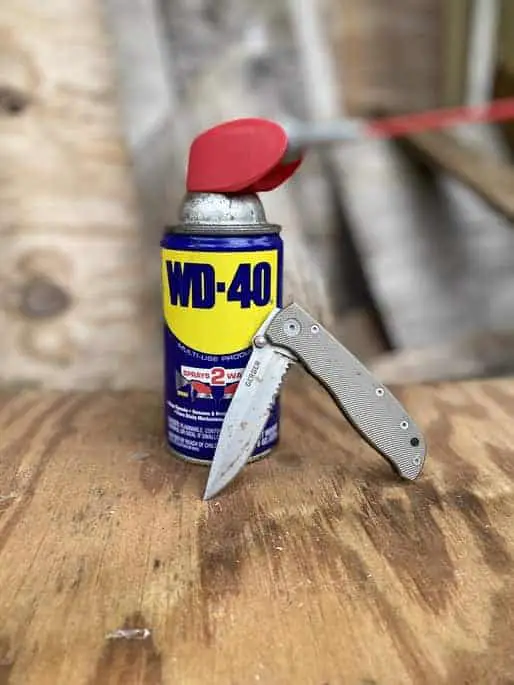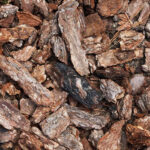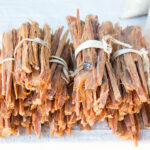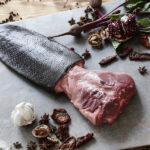WD-40 gets a lot of buzz around the internet as a great product to use when you want to keep any surfaces or objects shiny and lubricated. It’s a great product that generally lives up to the hype.
But can you use WD-40 on a pocket knife?
You can use WD-40 on a pocket knife as a quick cleaning solution. However, it doesn’t have similar properties to other lubricants. Therefore, it won’t protect your knife from rust or keep the moving parts ticking. Use WD-40 to clean your pocket knife, and use other oils to keep it lubricated.

The rest of this article will look at all you need to know about using WD-40 on your knife. You’ll also find possible alternatives you can consider.
Table of Contents
- Is WD-40 Good for Knives?
- What Oil Should I Use for My Pocket Knives?
- How Often Should You Oil Your Knife?
- Other Knife Care Tips
Is WD-40 Good for Knives?
WD-40 is good for knives because it won’t cause rust or damage. However, it’s only good when you’re looking for a cleaning solution. While it can loosen up dirt and grime on your knives, it doesn’t provide a protective film to prevent it from rusting.
If your knives have moving parts (as you’d find with most pocket knives), you need to be more careful when cleaning them with WD-40.
This solution tends to attract dirt to corners and joints, so your knife can quickly become unusable if you allow it to settle into these joints. You’ll have to spend more time cleaning out the dirt from these joints.
What Oil Should I Use for My Pocket Knives?
The right oil to use for your knives depends on what you’re using them for. For knives used in food preparation, it’s best to use food-grade mineral oils or vegetable oils. For knives used outdoors, you should only use quick-drying oils or lubricants.
If you have a pocket knife that you use during quick meals while out and about, you should only apply oils that won’t require you to wash the knife before use. Food-safe mineral oils like Thirteen Chefs Food Grade Mineral Oil (available on Amazon.com) work well because they can keep your blades sharp and rust-free. It’s easy to apply and is tasteless and odorless.
Since the oil is wet, you have to be careful when using it. You should only apply small quantities and clean off any excesses. Vegetable oils can also accomplish the same thing. However, they can go rancid and leave a bad taste in foods.
When talking about knives used when you’re outdoors, using oils that stay wet after they are applied isn’t the best idea. They can make your knives magnets for dirt, pocket lint, and other sediments in between. Therefore, you should only use dry lubricants.
One of the best types of dry lubricants you can use is the Sentry Solutions Tuf-Cloth (available on Amazon.com) is one of the best. When applied to your knife’s blade, it goes on wet but dries on the surface to give it a protective coat. The product has moisture-displacement properties and can inhibit rust.
Dry lubricants don’t work well on a knife’s moving parts, so for those areas, you can use products like the Militec-1 Lubricant. It’s easy to apply and will keep the parts moving instead of clogging them up as you’d get with WD-40.
How Often Should You Oil Your Knife?
You should oil your knife frequently if it’s constantly in use – up to seven times a year. If you only use the knife sparingly, you can get away with only oiling it 1-2 times every year.
Knives used heavily outdoors or those frequently exposed to the elements should be oiled weekly or bi-weekly to keep them in the proper condition at all times.
In fact, settlers and pioneers often oiled their knives every chance they had due to the harsh environment and conditions they lived and worked in. Beaver oil was one of their favorites!
Other Knife Care Tips
Oiling your knives is only one angle to taking care of them. Here are a few others you should keep in mind:
Sharpen Your Knives Periodically
A dull knife makes your job a lot harder and much more dangerous. You’ll have to exert more pressure to complete cuts, which increases the chances of slips and injuries.
A dull knife is dangerous!
Fortunately, you only need to sharpen your knives once a year, unless of course they are used heavily. So, it’s not too much work. You can use a whetstone to sharpen the knives on your own or take them to a cutlery store.
Hone Your Knives Frequently
It’s easy to confuse sharpening your knives with honing them, but they are different things. Sharpening reshapes the knife’s edge to make it sharper while honing aligns the edge and straightens out folds. Knives used regularly need honing before each use to make cutting through tough-skinned items easier.
Store Your Knives Properly
Cleaning your knives and oiling them will only yield your intended results if they’re stored properly, so you should make sure to store the knives in a way that the blades aren’t exposed. It’ll help you avoid injuries and further reduce the chances of rust accumulation.
You can also buy sheaths or plastic blade guards for your knives. With the blades covered, you can store the knives in a wooden or fabric knife rack.
- Neem Oil Deer Repellent: Does It Really Work?

- Is It Okay To Burn Bark In a Wood Stove?

- Do Deer Eat Morel Mushrooms?

- How To Properly Dispose of Wood Stove Ashes (Safely!)

- Is Fatwood Safe for Wood Stoves? Here’s What You Should Know

- Is Beaver Good to Eat? You May Be Surprised!

- Is Bread Bad For Deer? Here’s What You Should Know

- Are Roosters Good to Eat?

- 3 Easy Ways To Tell If Your Wood Stove Is Leaking
